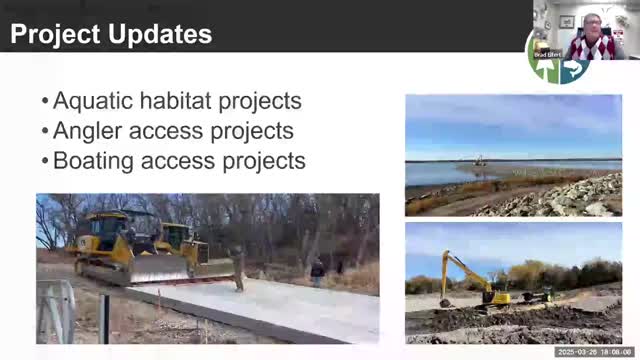NGPC completes major Methodist Cove restoration at Harlan Reservoir to reconnect shoreline habitat
January 01, 2025 | Nebraska Game and Parks Commission (NGPC), State Agencies, Organizations, Executive, Nebraska
This article was created by AI summarizing key points discussed. AI makes mistakes, so for full details and context, please refer to the video of the full meeting. Please report any errors so we can fix them. Report an error »

BRAD IFERT, South Central District manager for the Nebraska Game and Parks Commission, said the Harlan Reservoir Methodist Cove restoration — a roughly $10 million project funded primarily by a U.S. Army Corps of Engineers grant with additional money from Nebraska's aquatic habitat fund — is essentially complete and will reopen shoreline habitat for spawning and rearing.
The project restored a permanently connected cove at Harlan Reservoir by excavating a channel, removing accumulating sediment, installing breakwaters and shoreline rock and adding both artificial fish attractors and cedar tree clusters to provide refuge and spawning structure for crappie and bass. Brad Ifert said the work was designed to restore cove connectivity to the main reservoir, slow future sedimentation and improve both shallow and deep-water habitat.
NGPC staff said the work included dredging a channel about 1,100 feet long and 200 feet wide to an elevation near 1,936 feet — about 10 feet below full pool — to allow fish passage at a range of reservoir elevations. Contractors also constructed a roughly 600-foot west-side breakwater to deflect sediment, armored more than 1,000 feet of shoreline with rock, regraded a sediment basin above Methodist Creek to trap upstream material, and placed hundreds of cedar-tree clusters and approximately 300 artificial “spider” structures to add cover in both shallow and deeper water.
Ifert said agency biologists will monitor the cove as part of a multi-year evaluation with the University of Nebraska at Kearney to compare which types of added structure most benefit crappie and other species. He noted the project was timed to improve habitat that becomes inaccessible when reservoir mouths silt in during low water years.
Ifert also praised local volunteer efforts tied to Harlan: he highlighted an Eagle Scout project by Evan Folk of Kearney that rebuilt the Gremlin fishing pier damaged in the 2019 high water, saving agency resources and restoring angler access.
The NGPC said the project’s federal grant covered roughly 75% of costs, with the remainder paid from Nebraska’s aquatic habitat fund. The agency plans continued monitoring and site maintenance as contractors finish remaining punch-list items.
The project restored a permanently connected cove at Harlan Reservoir by excavating a channel, removing accumulating sediment, installing breakwaters and shoreline rock and adding both artificial fish attractors and cedar tree clusters to provide refuge and spawning structure for crappie and bass. Brad Ifert said the work was designed to restore cove connectivity to the main reservoir, slow future sedimentation and improve both shallow and deep-water habitat.
NGPC staff said the work included dredging a channel about 1,100 feet long and 200 feet wide to an elevation near 1,936 feet — about 10 feet below full pool — to allow fish passage at a range of reservoir elevations. Contractors also constructed a roughly 600-foot west-side breakwater to deflect sediment, armored more than 1,000 feet of shoreline with rock, regraded a sediment basin above Methodist Creek to trap upstream material, and placed hundreds of cedar-tree clusters and approximately 300 artificial “spider” structures to add cover in both shallow and deeper water.
Ifert said agency biologists will monitor the cove as part of a multi-year evaluation with the University of Nebraska at Kearney to compare which types of added structure most benefit crappie and other species. He noted the project was timed to improve habitat that becomes inaccessible when reservoir mouths silt in during low water years.
Ifert also praised local volunteer efforts tied to Harlan: he highlighted an Eagle Scout project by Evan Folk of Kearney that rebuilt the Gremlin fishing pier damaged in the 2019 high water, saving agency resources and restoring angler access.
The NGPC said the project’s federal grant covered roughly 75% of costs, with the remainder paid from Nebraska’s aquatic habitat fund. The agency plans continued monitoring and site maintenance as contractors finish remaining punch-list items.
View full meeting
This article is based on a recent meeting—watch the full video and explore the complete transcript for deeper insights into the discussion.
View full meeting
